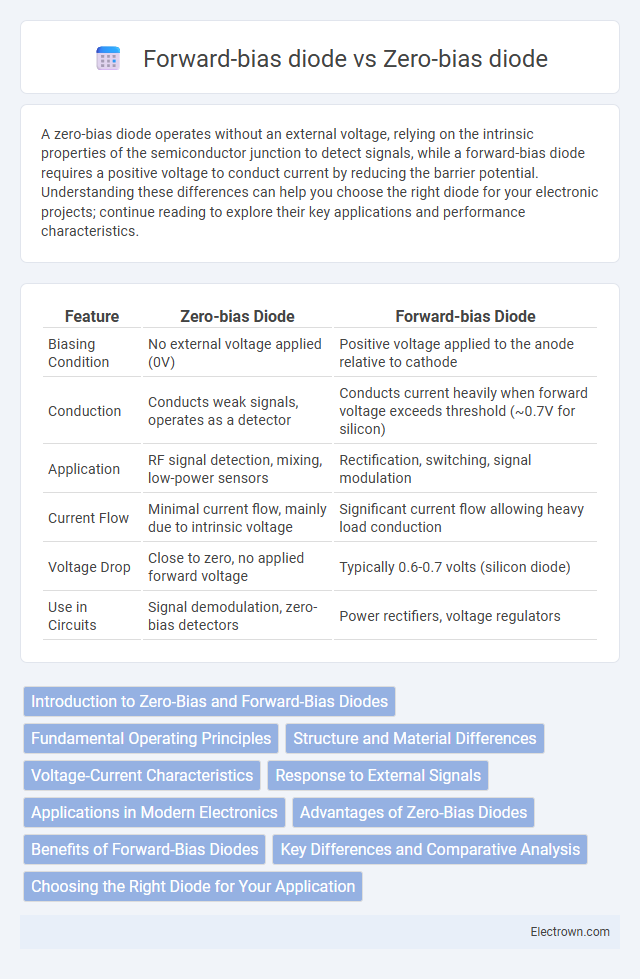A zero-bias diode operates without an external voltage, relying on the intrinsic properties of the semiconductor junction to detect signals, while a forward-bias diode requires a positive voltage to conduct current by reducing the barrier potential. Understanding these differences can help you choose the right diode for your electronic projects; continue reading to explore their key applications and performance characteristics.
Table of Comparison
| Feature | Zero-bias Diode | Forward-bias Diode |
|---|---|---|
| Biasing Condition | No external voltage applied (0V) | Positive voltage applied to the anode relative to cathode |
| Conduction | Conducts weak signals, operates as a detector | Conducts current heavily when forward voltage exceeds threshold (~0.7V for silicon) |
| Application | RF signal detection, mixing, low-power sensors | Rectification, switching, signal modulation |
| Current Flow | Minimal current flow, mainly due to intrinsic voltage | Significant current flow allowing heavy load conduction |
| Voltage Drop | Close to zero, no applied forward voltage | Typically 0.6-0.7 volts (silicon diode) |
| Use in Circuits | Signal demodulation, zero-bias detectors | Power rectifiers, voltage regulators |
Introduction to Zero-Bias and Forward-Bias Diodes
Zero-bias diodes operate without an external bias voltage, allowing them to detect or rectify signals passively, making them ideal for energy harvesting and signal detection applications. Forward-bias diodes require an applied forward voltage to conduct current, commonly used in power rectification and signal modulation where control of current flow is essential. Understanding the electrical characteristics and operation modes of zero-bias and forward-bias diodes is crucial for optimizing performance in RF circuits and power electronics.
Fundamental Operating Principles
A zero-bias diode operates without an external voltage applied, relying on intrinsic properties like the built-in potential barrier to detect signals, commonly used in radio frequency detection. In contrast, a forward-bias diode requires a positive voltage applied to the p-n junction, allowing current to flow easily as the potential barrier is reduced, enabling efficient rectification and circuit conduction. The fundamental difference lies in zero-bias diodes exploiting minority carrier effects under no external bias, whereas forward-bias diodes depend on forward voltage to initiate charge carrier injection and conduction.
Structure and Material Differences
Zero-bias diodes typically utilize Schottky-barrier structures composed of metal-semiconductor junctions, allowing for minimal voltage drop and fast switching speeds. Forward-bias diodes are usually made from p-n junctions in semiconductor materials like silicon, designed to conduct current when a threshold voltage is surpassed. Your choice between these depends on the required conduction characteristics and the specific electronic applications leveraging their structural and material properties.
Voltage-Current Characteristics
Zero-bias diodes exhibit a distinctive voltage-current characteristic where current flow occurs with minimal external voltage, primarily due to their built-in potential enabling rectification at zero or near-zero bias. Forward-bias diodes require an external forward voltage typically around 0.7V for silicon diodes, causing a sharp increase in current as the diode transitions from the cutoff to conductive state. The nonlinear I-V curve in zero-bias diodes is optimized for low voltage detection and signal demodulation, contrasting with the pronounced knee voltage and exponential current increase seen in forward-bias diodes during conduction.
Response to External Signals
Zero-bias diodes respond to external signals without requiring an applied voltage, making them ideal for detecting weak or high-frequency signals by exploiting their intrinsic junction properties. Forward-bias diodes need an external voltage to operate, creating a conductive path that allows current flow and signal rectification in power or signal modulation applications. Your choice depends on whether passive signal detection or active current conduction suits your circuit design.
Applications in Modern Electronics
Zero-bias diodes excel in high-frequency applications such as RF detectors and signal demodulation due to their low noise and fast response without requiring external biasing. Forward-bias diodes are widely used in power rectification, voltage regulation, and switching circuits where controlled current flow is essential. Understanding the distinct roles of these diodes helps optimize your electronic designs for efficiency and performance in communication systems and power supplies.
Advantages of Zero-Bias Diodes
Zero-bias diodes offer significant advantages such as ultra-low power consumption and minimal noise, making them ideal for sensitive radio frequency (RF) and microwave signal detection applications. Their operation without an external bias voltage enhances reliability and reduces circuit complexity, improving overall energy efficiency in wireless communication systems. Unlike forward-bias diodes, zero-bias diodes exhibit faster response times and better linearity, critical for high-frequency detection and rectification tasks.
Benefits of Forward-Bias Diodes
Forward-bias diodes offer efficient current flow with low resistance, enabling precise control in rectification and signal modulation. Their fast switching capabilities and stable voltage drop improve performance in power regulation and electronic circuits. These diodes provide enhanced conductivity and reliability, making them essential in power supply design and amplification applications.
Key Differences and Comparative Analysis
Zero-bias diodes operate without an external voltage, allowing small signal detection and noise reduction, whereas forward-bias diodes require an applied voltage to conduct current primarily used in rectification and power applications. The zero-bias diode's low noise figure makes it ideal for RF signal demodulation, while forward-bias diodes exhibit lower resistance and higher current flow suitable for power regulation. Performance comparison highlights zero-bias diodes' sensitivity at low signal levels and forward-bias diodes' efficiency at higher currents and voltages.
Choosing the Right Diode for Your Application
Zero-bias diodes operate without an applied voltage, making them ideal for high-frequency signal detection and low-noise applications, while forward-bias diodes allow current flow when voltage exceeds the threshold, suitable for rectification and power regulation. Your choice depends on whether you need efficient signal detection at minimal voltage (zero-bias) or controlled current conduction under applied voltage (forward-bias). Understanding the application's voltage and frequency requirements ensures selecting the right diode enhances performance and reliability.
Zero-bias diode vs Forward-bias diode Infographic

 electrown.com
electrown.com